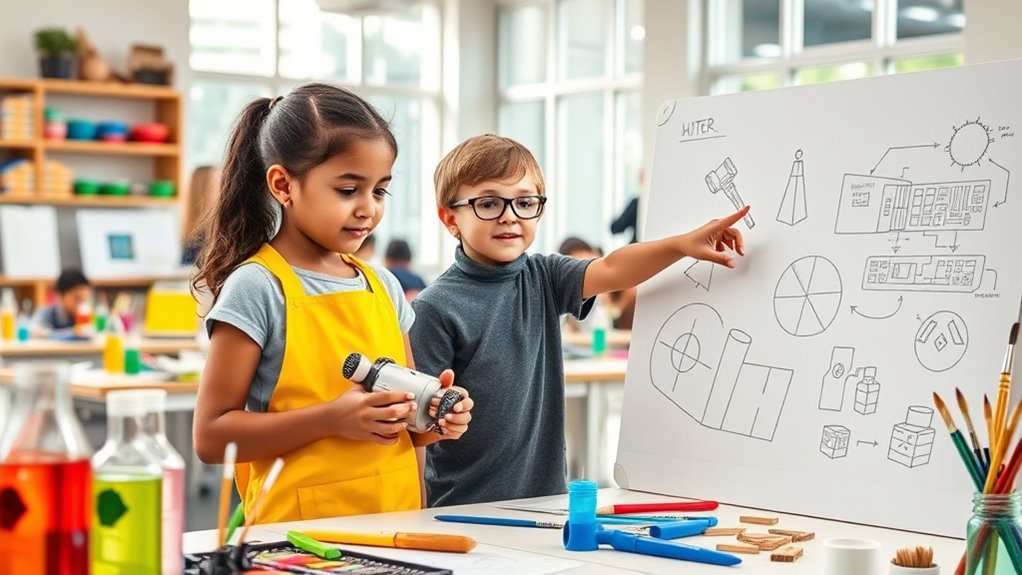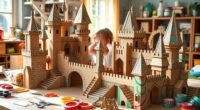Adding art to science transforms STEM into STEAM, blending creativity with technical skills to boost innovation and engagement. While STEM focuses on analytical thinking and problem-solving, STEAM encourages artistic expression, aesthetic design, and visual communication. This integration makes learning more dynamic, helping you develop both logical and creative abilities. If you want to discover how this approach prepares you for future careers and makes education more exciting, keep exploring further.
Key Takeaways
- STEAM integrates art into STEM, promoting creativity, innovation, and visual communication alongside technical skills.
- Adding art broadens engagement, encouraging hands-on, creative problem-solving in scientific and technological contexts.
- STEAM enhances data presentation and product design through aesthetic and visual elements.
- Incorporating art develops holistic skills like empathy and aesthetic sensibility, preparing students for diverse careers.
- The inclusion of art makes STEM learning more dynamic, engaging, and applicable to real-world scenarios.

When choosing between STEM and STEAM education, understanding their differences can help you make informed decisions about learning and career paths. STEM focuses on science, technology, engineering, and math, emphasizing analytical thinking, technical skills, and problem-solving. STEAM, on the other hand, adds art into the mix, encouraging creativity, innovation, and visual communication alongside technical knowledge. This inclusion can transform how you approach learning, making it more engaging and well-rounded.
In a STEAM environment, hands-on experiments are central to the learning process. By actively participating in projects, you’re not just memorizing facts but applying concepts in real-world scenarios. For example, building a robot or designing a sustainable model requires you to experiment, iterate, and learn from failure. These hands-on experiments foster creative problem solving—you’re constantly finding new ways to tackle challenges, often thinking outside the box. This approach helps you develop a flexible mindset, which is valuable in many careers, especially those blending science and art. Additionally, integrating emotional support strategies can help learners build resilience and confidence when facing setbacks during creative projects.
Adding art into STEM subjects broadens your perspective. It encourages you to think critically about how to communicate complex ideas visually, aesthetically, and meaningfully. You might create a visually appealing presentation of data or design an innovative product that’s both functional and beautiful. This process pushes you to combine technical skills with creativity, leading to more innovative solutions. It also makes learning more enjoyable, as it taps into your artistic side and allows self-expression.
Integrating art with STEM fosters creativity, innovation, and a more engaging, expressive learning experience.
The integration of art in STEAM doesn’t dilute the technical rigor but enhances it. When you incorporate creative problem solving, you’re often faced with questions like, “How can I make this more user-friendly?” or “What design will resonate emotionally with people?” These questions require you to think beyond formulas and numbers, cultivating empathy and aesthetics alongside precision. This holistic approach prepares you for a wide range of careers, from engineering and design to marketing and education, where the ability to blend technical expertise with creativity is increasingly valued.
Ultimately, choosing STEAM over STEM can give you an edge by making learning more dynamic and applicable. It encourages you to develop both your analytical abilities and your creative intuition through active engagement. Whether you’re designing a new app, crafting an art-inspired science project, or solving complex problems, the skills you gain from a STEAM education equip you to navigate a world that demands innovation and adaptability.
Frequently Asked Questions
How Does Integrating Art Improve STEM Learning Outcomes?
Integrating art into science enhances your STEM learning by fostering creative collaboration and encouraging interdisciplinary thinking. When you blend artistic expression with scientific concepts, you develop a deeper understanding and innovative problem-solving skills. This approach keeps you engaged, making complex ideas more accessible. Art sparks imagination, helping you see connections across disciplines and apply knowledge in new, meaningful ways, ultimately improving your overall learning outcomes and inspiring a lifelong passion for science.
What Are the Challenges of Combining Art With STEM Education?
When you combine art with STEM, you face challenges like fostering interdisciplinary collaboration and curriculum integration. You must guarantee teachers from different fields work together seamlessly, which can be difficult due to varying expertise and teaching styles. Additionally, integrating art into existing STEM curricula requires careful planning to balance subjects without overloading students. Overcoming these hurdles involves clear communication, flexible planning, and a shared vision for holistic learning.
How Can Teachers Effectively Balance STEM and STEAM Curricula?
Coincidentally, balancing STEM and STEAM curricula hinges on your ability to foster interdisciplinary collaboration. You can achieve this by designing projects that seamlessly integrate art with science, making curriculum integration natural and engaging. Encourage students to explore connections, breaking down traditional subject boundaries. By doing so, you’ll create a dynamic learning environment where creativity enhances scientific understanding, ensuring both disciplines complement each other without overshadowing their unique contributions.
Are There Specific Art Forms Most Compatible With STEM Subjects?
You might wonder which art forms best complement STEM subjects. Visual arts, like drawing and design, help students visualize complex concepts and foster creativity. Performing arts, such as drama and music, enhance collaboration and communication skills essential in science and engineering. Incorporating these art forms into STEM can make learning more engaging and accessible, encouraging students to think creatively while applying scientific principles.
How Does STEAM Influence Student Creativity and Innovation?
You’ll find that STEAM encourages cross-disciplinary collaboration, which boosts your creativity and innovation. By integrating art into science and technology, you’re better equipped for creative problem solving, as it opens new perspectives and ideas. This approach helps you think outside the box, fostering a mindset that values diverse skills and viewpoints. Ultimately, STEAM cultivates your ability to innovate through collaborative efforts and creative exploration.
Conclusion
Now that you’ve seen how art transforms science into something even more engaging, imagine what’s next. Will adding creativity open new doors you never considered? The line between STEM and STEAM isn’t just blurred—it’s disappearing, revealing endless possibilities. So, are you ready to take that leap and explore where art and science can truly take you? The future’s waiting, and it’s more exciting than ever. The question is—are you ready to be part of it?










